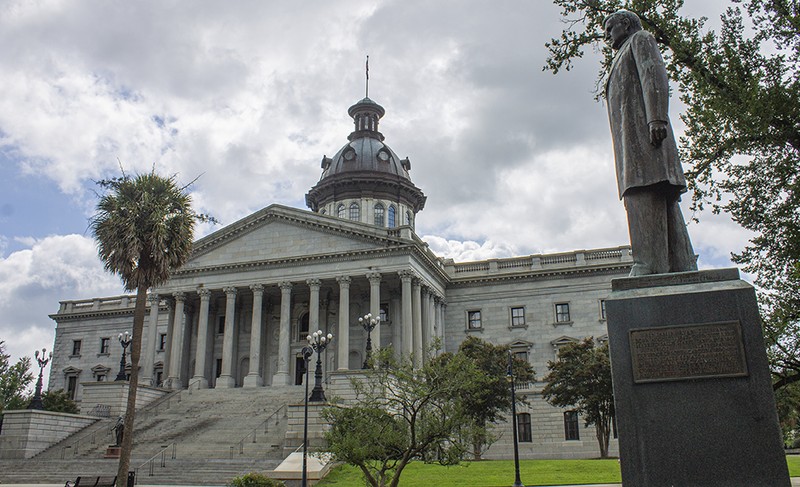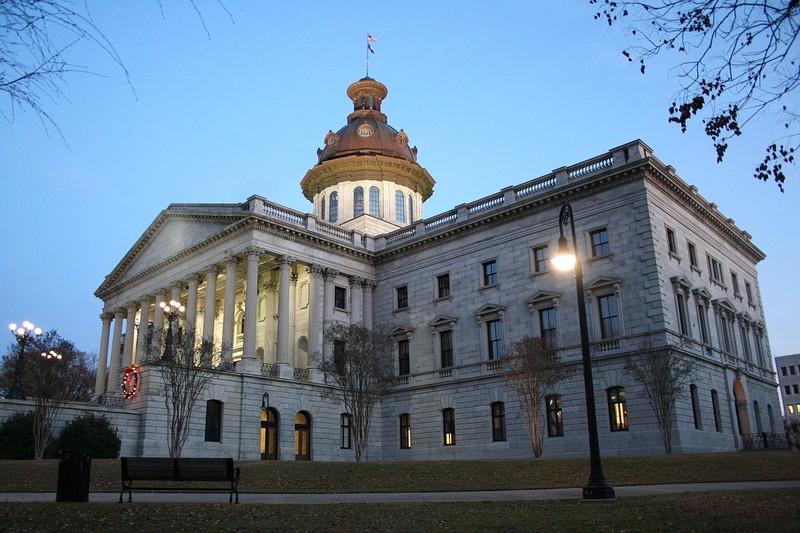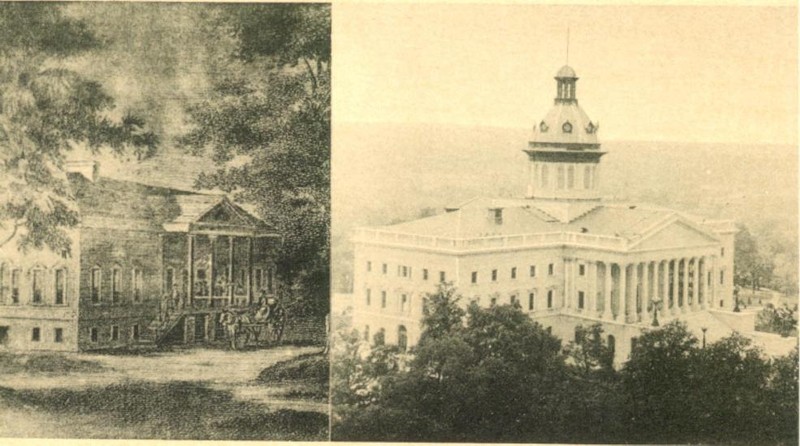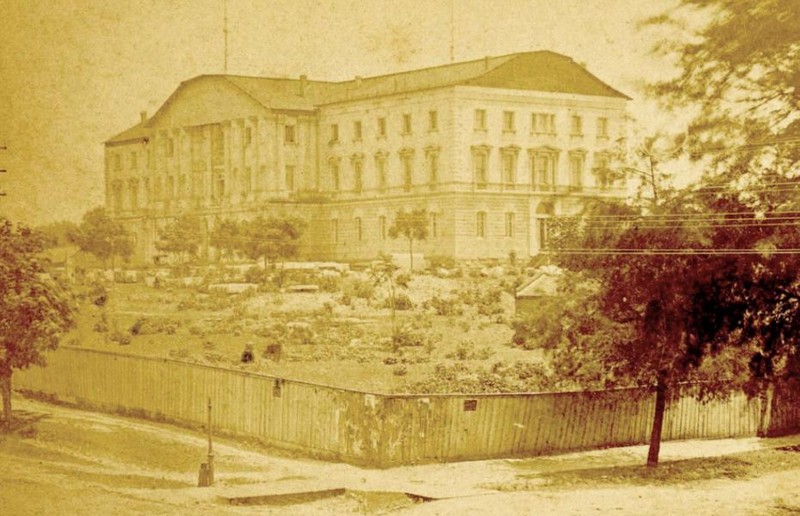South Carolina State House
Introduction
Text-to-speech Audio
Images
South Carolina State House, 2019, with the Benjamin Ryan Tillman Monument in the foreground.

South Carolina State House.

Postcard depicting the original State House/County Courthouse (1794) and the current State House, seen in 1936.

South Carolina State House, 1873.

Backstory and Context
Text-to-speech Audio
The present South Carolina State House is the state's third capitol building and was completed in 1903. Construction of the first South Carolina State House actually predates the state and was also located in Charleston. Construction of that building began in June of 1753 and the first meeting of the South Carolina Assembly occurred three years later. The interior of the colonial capitol of South Carolina was not finished until the 1760s. Located on the northwest corner of Broad and Meeting Streets, it was made of brick covered with strucco, and had a central pavilion with four composite-order columns. When the building burned down in 1788, reconstruction began immediately but that new building would serve as the Charleston County Courthouse as a decision had already been made in 1786 to construct a new state capitol.
Work on the second state capitol building began in 1786 and that building was located at the corner of Senate and Richardson (Main Street today). That building was completed and served the first legislative session in 1790. This second State House was made of wood with stuccoed brick at the base, and had offices on the ground floor with legislative halls on the second. Although it was a new building, it deteriorated quickly due to its poor construction, requiring the legislature to make numerous appropriations for repairs throughout the 1840s. In 1849, Governor Whitemarsh B. Seabrook became concerned not only with the cost of maintaining the building, but also with the poor conditions in which official records and documents were being stored on the ground floor. The General Assembly authorized the construction of a third, new capitol building, requiring that a fireproof building be constructed adjacent to the statehouse for archival storage and to serve as a “basement story” wing of the new capitol building if necessary.
Construction began on this building in 1851, and by 1854, the General Assembly approved $50,000 to complete the new fireproof building. However owing to design flaws, budget issues, the Civil War, and political disagreements in the second half of the 19th century, construction lasted until 1903. The first architect on the project was Peter Hjalmar Hammarskold, but after the legislative commission overseeing the construction discovered structural flaws in the foundation created under his supervision, he was dismissed in June of 1854. Hammarskold’s work had to be dismantled, not only setting building completion back, but also causing a loss of $72,267 to the state. Hammarskold was replaced by George E. Walker, who also was dismissed after only eight months after officials declared he suffered from “temperamental outbursts, political ineptitude, and managerial shortcomings.”
Work finally moved quickly on the State House when Walker was replaced with Baltimore architect John R. Niernsee, who officially began work in 1855. Under Niernsee, 375-500 men were part of the construction effort which began with cutting and hauling stones from a quarry near the Congaree River. Sixty percent of these men were enslaved African Americans, and many of the other laborers were Irish immigrants, By 1860, $1,240,063 had been put into the building under Niernsee. By 1861, the exterior walls were nearly complete, but the building had no roof or interior finishes.
The Civil War brought work to a standstill. On February 17, 1865, General William T. Sherman and the United States army captured the city. Fires set both by retreating Confederates and advancing United States soldiers spread throughout the city and the former State House was burned to the ground. The new and incomplete structure that now serves as the state capitol was an easy target for Union cannoneers. The unfinished building was fired upon from the west bank of the Congaree River, and today, six bronze stars mark where the shells damaged the granite walls. Although the new building was spared from the fires, the building materials stored at the site were not. Around $700,000 worth of materials intended for the legislative halls and lobby were destroyed.
For a few years following the war, former Confederate leaders were disfranchised which led to the first and only African American majority state legislature in the history of the United States in 1869. During these years, a temporary roof and interior finishes were installed in the building. Work on the permanent roof and interior resumed in 1885, but by that time, Niernsee’s health was failing and he only completed drafts of his final construction plans before his death on June 7, 1885. Niernsee’s former partner, J. Crawford Nielson was hired to complete the legislative halls, but once again, disputes also led to Nielson’s dismissal. Niernsee’s son, Frank McHenry Niernsee, took control in 1888, installing galvanized metal ceilings, fireproof floors, cast-iron staircases, galleries, and balconies. By the fall of 1890, the interior was complete, and Frank Niernsee requested $75,000 to begin work on the north portico. When the legislature instead only appropriated $4,500 to him, he ended his work on the State House in 1891. Frank P. Milburn finished the exterior with $175,000 approved by the General Assembly, adding porticos and a dome with 44,000 pounds of copper between 1901 and 1903.
When the State House was officially completed in 1903, it's cost had increased to around $3,540,000 and the process of construction had taken over half a century. The completed structure was reflects the Neo-Classical style which can be seen in many other state capitols and government buildings. The structure is made of native blue granite from the Congaree Quarry two miles from the site. Due to respect for historic design and because of financial issues, the legislature rejected proposals to enlarge the building in the 1910s, in 1946, and once again in 1995. Instead, the building saw minor alterations throughout the 20th century such as the remodeling of the Senate in 1913, the House in 1937, the governor’s office in 1966, the installation of air conditioning from 1959-1960, and the renovation of the lobby in 1962.
The first full-scale renovation began in 1992, totaling a cost of $51,530,000 upon its completion in 1998. New mechanical systems were installed, the interior was refurbished, the building was made handicapped-accessible and compliant with current fire and safety codes, and a seismic protection system was installed in the case of an earthquake such as the one that devasted Charleston in 1886. On June 5, 1970 the South Carolina State House was listed on the National Register of Historic Places, and on May 11, 1976, designated a National Historic Landmark.
Cite This Entry
Zarilla, Olivia and Clio Admin. "South Carolina State House." Clio: Your Guide to History. November 23, 2020. Accessed March 28, 2025. https://theclio.com/entry/119279
Sources
- Vivian, Daniel J.. State House, South Carolina Encyclopedia. November 18th 2016. Accessed November 13th 2020. https://www.scencyclopedia.org/sce/entries/state-house/.
- South Carolina State House, Historic Columbia. Accessed November 13th 2020. https://www.historiccolumbia.org/online-tours/state-house-monuments-tour/south-carolina-state-house.
- South Carolina Statehouse, Richland County (Main & Gervais Sts., Columbia), South Carolina Department of Archives and History. Accessed November 13th 2020. http://www.nationalregister.sc.gov/richland/S10817740006/index.htm.
- The State House History, South Carolina State House. Accessed November 13th 2020. https://www.scstatehouse.gov/studentpage/Explore/history.shtml.
- SC State House, SC Picture Project. Accessed November 13th 2020. https://www.scpictureproject.org/richland-county/sc-state-house.html.
https://www.historiccolumbia.org/online-tours/state-house-monuments-tour/south-carolina-state-house
https://www.scencyclopedia.org/sce/entries/state-house/
https://www.historiccolumbia.org/online-tours/state-house-monuments-tour/south-carolina-state-house
https://www.historiccolumbia.org/online-tours/state-house-monuments-tour/south-carolina-state-house

